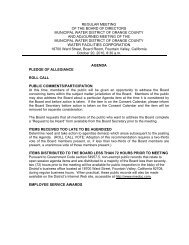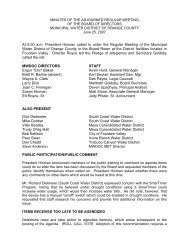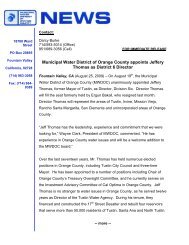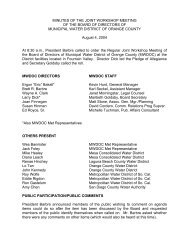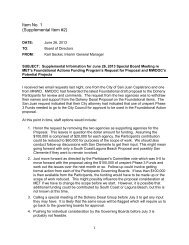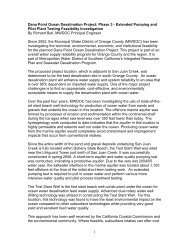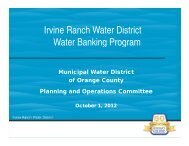UWM Plan - Municipal Water District of Orange County
UWM Plan - Municipal Water District of Orange County
UWM Plan - Municipal Water District of Orange County
You also want an ePaper? Increase the reach of your titles
YUMPU automatically turns print PDFs into web optimized ePapers that Google loves.
4.2.13. DMM 13: <strong>Water</strong> Waste Prohibition<br />
Section 4<br />
Demand Management Measures<br />
Due to our water supply situation, in 2009 Metropolitan and MWDOC partnered to<br />
develop a water waste prohibition template for adoption by retail water agencies.<br />
MWDOC and Metropolitan worked together to develop a Model <strong>Water</strong> Conservation<br />
Ordinance as a tool to assist local agencies to adopt and enforce local water conservation<br />
ordinances in hopes <strong>of</strong> increasing water use efficiency. The model ordinance form and<br />
structure is consistent with many existing water conservation ordinances and contains<br />
provisions contained in the CUWCC BMP 13 and DWR’s Urban Drought Guidebook. In<br />
essence, the Model Ordinance provides a menu <strong>of</strong> options for agencies to better control<br />
local water use and address current water supply conditions within their jurisdictions.<br />
The Model <strong>Water</strong> Conservation Ordinance includes permanent water-waste prohibitions,<br />
existing water restrictions to be implemented over three water-supply shortage<br />
conditions, penalties and violations, and other general provisions for consideration. The<br />
permanent water-waste restrictions include primarily behavioral measures such as<br />
limiting irrigation times, prohibiting the washing <strong>of</strong> paved surfaces, and controlling<br />
excessive run<strong>of</strong>f.<br />
The Model’s escalating water restrictions levels mirror Metropolitan’s <strong>Water</strong> Supply<br />
Alert resolution and progress from permanent baseline restrictions to mandatory<br />
reductions during a water supply allocation. The Model Ordinance purposely does not<br />
contain specific triggers for determining water supply levels, such as a certain percentage<br />
<strong>of</strong> required water reduction or certain amount <strong>of</strong> reduction in supply. The number <strong>of</strong><br />
escalating water restrictions levels and the actual triggers for determining particular water<br />
supply conditions is left to the discretion <strong>of</strong> the adopting entity. The Model Ordinance<br />
contains penalty provisions that allow for criminal, civil, and administrative enforcement,<br />
and include such penalties as monetary fines, water flow-restrictions. The Model<br />
Ordinance also contains other provisions for adopting entities’ consideration, including<br />
requirements to utilize recycled water, development <strong>of</strong> water conservation plans waterwaste<br />
hotlines, limit on new building permits, and implementation <strong>of</strong> water allocations.<br />
Through this effort, the vast majority <strong>of</strong> MWDOC’s retail water agencies used the Model<br />
Ordinance to adopt new <strong>Water</strong> Conservation Ordinances.<br />
<strong>Municipal</strong> <strong>Water</strong> <strong>District</strong> <strong>of</strong> <strong>Orange</strong> <strong>County</strong><br />
2010 Regional Urban <strong>Water</strong> Management <strong>Plan</strong><br />
Final<br />
4-24



